Farewell Cards
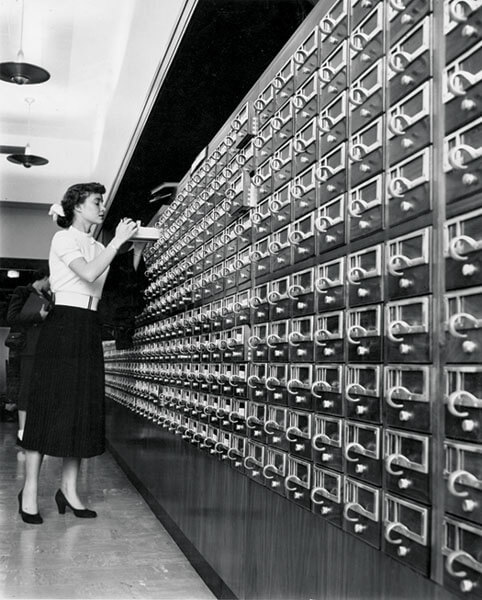
When Memorial Library opened in 1953, the university anticipated adding thousands of titles to its card catalog. Note the lack of labels on the drawers in the foreground.
Memorial Library bids an overdue adieu to its card catalog.
Ladies and gentlemen, I give you the catalog card.
For alumni above a certain age, no introduction is necessary: the card is an old college friend, the key to unlocking the mysterious vaults of knowledge within the UW libraries.
But alumni under a certain age will wonder what in the world I’m talking about. For their benefit, perhaps a description is in order. A catalog card is a rectangular piece of white paper — 110-pound cardstock — seventy-five millimeters tall by one hundred twenty-five wide. Centered along the bottom, four millimeters up from the edge, is a small hole.
For the better part of a hundred years, the catalog card was essential to study and research. But it’s been obsolete for more than a quarter century now, and as the spring semester wrapped up in May, Memorial Library finished the process of dismantling its card catalog, the largest on campus and one of the last.
Memorial Library hasn’t added a card to its paper catalog since August 1987. Over the ensuing years, the library has been engaged in a project called retrospective conversion — that is, converting all of the card data into digital records so that patrons can find them by searching on MadCat, the UW Libraries’ online catalog.
For those younger alumni, that announcement may produce no more than a shrug, as librarian Irene Zimmerman notes that it did from some students she knows.
“They’d never used a card catalog,” she says. “Not the one here, or anywhere else.”
But the passing of the card catalog marks the end of an epoch for the university — or perhaps the end of an epic would be more appropriate. The effort to computerize the card data has taken more than twice as long as the Trojan War. [1]
Now, at the end of the 2012 academic year, the library finally feels ready to let go of the paper that, for generations, has filled Memorial’s Room 224.
“We had to feel confident in the fact that we have [the data to represent the entire library collection] and that we have it in numerous formats and places to ensure both its integrity and longevity,” says Lee Konrad ’86, MA’92, the associate director of library technology. To give up the cards, he says, “You have to wait until the right time. And that time, for many research libraries, was ten years ago. For UW–Madison, that time is now.”
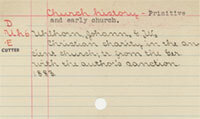
The UW’s oldest catalog cards were handwritten using a script devised by Melvil Dewey and Thomas Edison. Library Hand was a required element in a librarian’s education. Note that the subject line has been altered during the typewriter era.
Put on NOTIS
According to legend, the concept of the card catalog began in late-eighteenth-century France. As revolutionaries liberated the libraries of aristocrats and monasteries, the state found itself with a great many books. Radical bibliographers used playing cards to keep track of their burgeoning collections.
It’s a colorful story, and who knows? Maybe it’s even true. But whatever the forces of liberté, egalité, and fraternité were doing in Europe, the catalog card was a foreign concept when the UW first opened its doors. The university’s initial lists of library holdings came in book form.
It wasn’t a terribly impressive collection. The 1851 catalog, for instance, notes that the library had just one volume on the subject of engineering: W. Gillespie’s Roads and Rail Roads. [2] But it was a growing collection, and that was the problem with a catalog as a bound book: it was hard to change.
Some time in the 1880s, the libraries adopted card catalogs — a giant leap forward, technologically. Cards could be added, subtracted, corrected, and updated individually, without the need to reprint the whole list.
Still, the first installments in that early card catalog were somewhat laborious, penciled out in a cursive script known as Library Hand, which had been developed by Melvil Dewey [3] (of Decimal System fame) and Thomas Edison specifically for use on cards.
“They’re rather hard to read today,” says Jamie Woods MA’81, the General Library System head of original cataloging. “We’re not used to that kind of cursive handwriting.”
By the end of the nineteenth century, typewriters were replacing Library Hand, and soon the UW was acquiring pre-printed cards with standardized cataloging information created by the Library of Congress — the system that the UW Libraries would follow up to the 1980s.
And that’s libraries plural; there are forty-nine of them on campus. Sixteen are governed by the General Library System (GLS), including the largest collections — Memorial and the life science library in Steenbock and College Library in Helen C. White Hall. Most of the rest are held within professional schools and colleges — law, medicine, education.
The vast size of the university’s holdings and their many locations presented a difficult burden for the cards, and one that the UW Libraries started addressing in 1982 with the next great technological leap: the launch of the Network Library System (NLS). Developed specifically for the UW and the University of Chicago by IBM, NLS was the university’s first attempt at a computerized catalog. But it was never finished and was abandoned in 1987 for a more fully developed system called NOTIS.
“I won’t say it was great at that time,” admits Konrad, who came to the UW as an undergrad during the NLS experiment. “At that point, not a lot had been converted yet, so you had to work in both [paper and digital] environments to be sure you had discovered all the material relevant to your topic. Though challenging at the time, however, the conversion of the catalog was certainly transformative, with respect to nearly every aspect of library services.”
The university abandoned NOTIS in 1999 for a system called Voyager, which is the basis of today’s MadCat online catalog. But throughout the 1980s, the advantages of an electronic catalog over paper cards were becoming more and more apparent. Chief among these are that cards take up a lot of space and limit the ways in which a person can search for a book.
Some of those limitations are arbitrary, notes Michael Cohen MA’77, MA’82, the GLS interim head of cataloging. “Take authors,” he says. “If a work had three authors or fewer, each would get an individual author card. If there were four or more authors, there would be just one author card. This made for convenient cataloging, but inconvenient searching.”
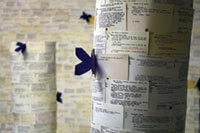
Not all of the cards are headed for recycling. Angela Richardson used stacks of them in an art project called Lepitopterarium. The butterflies are made from microfiche slides. Paul Andrews and Angela Richardson.
House of Cards
So if the card catalog took such shortcuts for convenience, why has the job of turning it into computer records taken so long? There are two reasons. The first is money: unlike the UW’s schools, colleges, and academic departments, the libraries don’t have fond alumni to give unrestricted dollars.
“We don’t have any graduates of the library, even though we have more than 4 million people walk through our doors each year,” says interim director Ed Van Gemert ’72, MA’78. “With the budget reductions — plural — it’s more and more difficult to maintain personnel and resources at every level.”
With limited funds, the libraries have had to triage their needs, focusing efforts on keeping up with their many new acquisitions. In the most recent year for which records are available, the UW Libraries received 134,118 new volumes.
But though the library wishes to free up the card catalog’s 30,000 square feet of space by turning paper records into digital ones — by completing that retrospective conversion — the job is immense, which is the second problem. Precisely how immense no one knows, though Zimmerman, who serves as interim head of the libraries’ technical services division, figures the libraries have about 7,447,000 cards on their hands.
But that’s just the cards that Memorial had at the start of this academic year. Previously, there was also the subject catalog, which the libraries disposed of in January 2011. These included another estimated 3,894,000 cards. So when that last card was added in 1987, the UW’s public card catalog probably contained something north of 11 million slips of paper. If they’d all been stacked up, one on top of another, the pile would stand nearly 1.8 miles high. If they were laid out end to end, they’d stretch — well, not all the way around the world, certainly, but almost all the way from Memorial Library’s front door to the entrance to the Harry Elkins Widener Library at Harvard University. [4]
The point is, it’s a lot of paper. Now the retrospective converters didn’t have to type a MadCat entry for each card in the public catalog, just one for each title the UW owned. Because each book, book series, or journal had not only a title card, but also cards for subject (often more than one) and author (sometimes more than one), that cuts down on the job somewhat. But in August 1987, the UW had 4.7 million titles. That’s still a lot of work, and retyping all of the data on the cards into a database has taken a lot of person-hours — many of them from just one person.
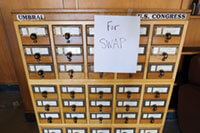
Old technology doesn’t die — it just goes to SWAP. More than 100 catalog cabinets are being sold through the UW’s surplus program, fetching $120 or more apiece. Buyers use them to store tools, crafting supplies, wine, and more. Jeff Miller.
Treasure Hunt
Room 324 on the third floor of Memorial Library is a cavernous space, and since Memorial opened in 1953, it’s been home to the cataloging department. Near the very middle of the room, partitioned off by four mismatched fabric walls, is the cubicle that serves as the palace of the Retro Queen: Ellen Sandow. The nickname is one she gave herself, on her Facebook page. She considers herself the greatest retros-pective converter ever, and she’s no doubt right.
Sandow has been performing retrospective conversion for the UW Libraries since the project’s beginning in 1988, and today, she pretty much is the retrospective conversion department — the only person whose sole responsibility is to convert cards to digital data.
Over the years, the staff performing that task has grown and shrunk, depending on how much money the libraries could spare. Most of the workers were limited-term employees or LTEs: part-timers and project workers. Sandow was the unit’s only permanent staff member. In 2010, budget cuts forced the libraries to drop all positions but Sandow’s. Even after she officially retired, she returned, now an LTE herself, to continue the work.
“I hope to live long enough to see the project finished,” she says.
Sandow has retrospectively converted more card records into computer records than anyone else, and she set the standards for speed and accuracy. Just ask Mark Finster ’70 of the School of Business. In 1994, he taught a class in Total Quality Management that included a project aiming to improve the process.
“They came in here to try to show us how to be more efficient,” Sandow says. “But they couldn’t beat me. They couldn’t come up with anything that would be faster than I am.”
Her process is fairly simple. Books come to her on a rolling bookshelf, and one by one, she looks them up in a vast, international online database called OCLC. [5] If someone has cataloged the book before, she exports the data into the UW’s online catalog. If not, she types in the information from the card. Then she clicks a small, metal counter she keeps on her desk, tallying one more book done, and reaches for the next. Each month, she reports the number to Zimmerman.
“I like the monotony, the repetition,” Sandow says. “I like working the numbers and seeing them pile up. I’m doing what I love.”
And the job she loves won’t end soon. Although the card catalogs are now retired, Zimmerman estimates that the work of getting all of the libraries’ materials into MadCat is now only 98 percent complete. That means that there are still many thousands of titles left to enter. Most of these are what Zimmerman categorizes as “analytics”: items that should have individual records, but that were lumped together with other items when they were first cataloged. These might include a series of lectures or papers delivered at a conference. Some of these collections are many volumes thick; others have multiple titles by different authors bound in the same volume. Zimmerman guesses that there might be 150,000 of these analytics in the monograph collection, and maybe 150,000 more in the journal collection.
And these estimates don’t include those books that the library doesn’t know it has — books that haven’t been seen by the circulation desk in decades. Zimmerman has a team of students who prowl the stacks looking for these items, to bring them to the Retro Queen.
“We don’t really know how many [unconverted works] there are,” she says. “We won’t know until we’re done.”
The library calls the project hidden treasures, “and some of [the items found] are true treasures,” Sandow says. “We found a book that was published in the 1600s, several published before 1800. You kind of smell them and touch them and then [convert them and] take them up to Special Collections.”
Recycling
Though the card catalog itself is gone, students are still coming into contact with the cards — though few probably recognize what they see. Like any institution with budget concerns, the UW Libraries have become adept at recycling, and are turning the old catalog cards into scratch paper. Stacks are set in boxes next to each computer station in Memorial Library so that patrons can jot down the call numbers of the books they seek.
Not all of them will end up in the scrap heaps, however. Jamie Woods pulled aside samples from a variety of different eras so that the Catalog Department will have a record of the different ways in which cards were made.
“Jamie’s a bit of a historian,” says Michael Cohen, “or maybe a better term is antiquarian. He likes that kind of stuff.”
Others have been claimed by people with sentimental attachments to particular works. Zimmerman notes that authors — or often the descendants of authors — want to retain the cards for specific books. Library student Laura Damon-Moore MAx’12, for instance, snagged a hundred or so cards, including a stack related to Herman Melville. Her father, Dennis Moore, had written his dissertation on Billy Budd, [6] and so Laura and her sister Stephanie used the cards to make him a collage as a Christmas present.
“We matted them and framed them,” Damon-Moore says. “It was really lovely.”
And then there are people such as artist Angela Richardson [7] ’93, MFAx’15 who want to keep alive the memory of objects that were once central to the library experience. She asked Memorial Library for a large collection of cards — fifteen beer cases full — for use in Bookless, an art show at Madison’s Public Library in January 2012. Titled Lepidopterarium, her piece also includes microfiche slides cut into the shapes of butterflies (an imaginary species: Caeruleus bibliothecaris or “library blues”). She used the catalog cards to paper the walls of a small room, creating a landscape on which to display the cellophane insects.
The theme of Lepidopterarium, she says, is metamorphosis, suggested by the transformation of paper cards into digital data. Catalog cards “are fun and interesting to look at,” she says. “They’re beautiful little objects. Digital tools are incredibly powerful, but you get a different experience from thumbing through and browsing cards in a catalog. It’s tactile, and the digital process loses something.”
But many of the library staffers whose job it was to file those cards feel less nostalgia for their passing. Zimmerman didn’t keep any, and neither did Van Gemert. When he was an undergrad employed at the library, and later as a newly hired staffer, part of Van Gemert’s job was filing one to two inches of new cards each day.
“I filed more cards into that catalog than I care to admit,” he says. “Everybody would get a pack every week, and I don’t know if there was a policy or anything, but I couldn’t stand to let them get backed up.”
Cohen, who’s worked in libraries — on campus and off — since 1977, puts his feelings more bluntly. “I hated them,” he says. “I hated filing those cards when I had to do it, and I’m glad to see them go.”
Reshuffling the Deck
But recycling the cards themselves isn’t the issue that occupies library leadership — it’s recycling the area they used to live in: Memorial Library’s Room 224.
One of the leading ideas is to devote the old catalog room to something called the Humanities Research Bridge, a collaborative effort among the libraries, the College of Letters & Science, and the UW’s Division of Information Technology aimed at supporting research in the humanities.
“There’s a growing interest in collaborative humanities work,” says Konrad, “the kind that requires collective expertise to carry out a given project. We anticipate that, for this type of work, faculty and students will need seminar and presentation spaces to discuss their work, and small meeting spaces where you might expect to find a range of people, including faculty, computer scientists, visualization experts, librarians, campus technologists, and so on. The spaces and services we provide should help facilitate the mixing and matching of scholars and campus technologists engaged in computational work such as data mining, analysis, and visualizations.”
The possibilities for the new space excite Van Gemert.
“We envision collaborative areas,” he says. “We envision seminar space. We envision spaces where faculty could work with graduate students. I see technology as being a big part of the room. I see the capability of video conferencing with other collaborators around the country.”
But at the moment, the plan remains in the visionary stage. The most recent director of the libraries, Ken Frazier, retired in January, and a search for his successor has just begun. Any plan to transform Room 224 would tie up space and money, and both are scarce resources for the library.
“It would probably be best to wait until a new director is here to make a determination as to what’s best for the library,” says Konrad. “It’s a long-term commitment. For now, we are concentrating on the services that are not space dependent, such as workshops, speaker series, and consultations.”
As a result, Van Gemert believes Room 224 will likely remain an open study space at the start of the 2012–13 academic year.
A Lot of Wood
Disposing of the card catalog doesn’t just create an excess of paper and a new space to fill. It also frees up a lot of furniture: hundreds of cabinets designed to hold three-by-five cards now have no purpose on campus.
Most of the cabinets were acquired in the 1950s or earlier. Built by Globe-Wernicke (a firm that hasn’t existed under that name since 1963) and Remington Rand (a brand that ceased in 1955), the typical model stands five feet tall and three and a half wide and weighs in at 350 pounds.
Some of them will be saved. If and when the Humanities Research Bridge moves into Room 224, it will inherit rows of catalog cabinets that were built into the walls. And library staff have also set aside a few thousand cards to remind the space’s new inhabitants of what went on before their arrival.
“There are plans to keep at least half a dozen of the catalog drawers with some of the contents,” says Konrad. “We’d like to tie in — to whatever we ultimately do in the space — some physical connection to our past, in an attempt to provide some insight as to how standard library conventions started and what such standards made possible in the digital age. The physical catalog will always be an important and interesting piece of our history.”
But the rest of the cabinets — some 117 of them — are being shipped off to SWAP (Surplus with a Purpose, the UW’s surplus warehouse) to be sold. According to SWAP’s Tom Bessey, the cabinets go for about $120 apiece, though some have fetched more than $400 at auction. Demand has been high.
“They’ve been going pretty well,” he says. “Every time we [list one for sale online], it goes out on Facebook and Twitter and is re-tweeted. I’ve been kind of surprised.”
Demand comes from store owners who want to use them to display products, from crafters who want them to store art supplies — even from people who want to install a prefabricated wine rack.[8] There are, it seems, many uses for obsolete library technology.
“If nothing else,” notes Irene Zimmerman, “they’re the perfect size for storing cassette tapes.”
Footnotes
- Read about it in Homer’s Iliad, which you can find in English on the fifth floor of Memorial Library, south stacks, at PA4025 A2 F5 1975, or in classical Greek in Memorial Library’s Cutter collection, on the fourth floor, south stacks at X32Y H8 1950. If you’re interested. <
- There were, by comparison, twice as many books on the subject of conchology, which is the study of seashells. Sure, “twice as many” means there were just two, but you get the point — the UW’s library was not particularly awesome in 1851. <
- For an example, see Library Handwriting, available in the School of Library and Information Studies Library, in Helen C. White Hall, at 652.1 N42L. Oddly, the SLIS library uses the Dewey Decimal System rather than Library of Congress, which the rest of the UW Libraries use. <
- Actually, you’d run out of cards somewhere east of New Braintree, Massachusetts. But you’d get there — and farther — if you add in the cards from the shelf list. This was the non-public portion of the card catalog, and it held exactly one card for each title, arranged in order by call number. The librarians used it as the official list of the UW’s holdings. Add in its 4.7 million cards, and you’d have enough to shoot right by Cambridge and land in the Atlantic Ocean. <
- Back in 1967, when OCLC was new, the letters stood for the Ohio College Library Center — it was formed by a consortium that included Ohio University, Ohio State University, and other higher ed institutions in the Buckeye State that wanted to create a general computerized catalog system. Later, the abbreviation came to mean Ohio Computer Library Center. Later still, after the advent of the Internet, it came to stand for the Online Computer Library Center. Now the letters don’t seem to stand for anything at all. It’s ironic, but this is the kind of thing that used to drive library catalogers crazy. Imagine books for which OCLC is listed as author (and there are 85 of them in the UW’s libraries) or is named in the title (54 more). Changing the meaning of an abbreviation could mean correcting and refiling a lot of cards. <
- Look for it at PS2384 B54, both in College Library (first floor) and Memorial (second floor, north stacks) — or listen to the opera version, available on vinyl in the Mills Music Library at call number LP681726. <
- Her works include the videos Chicks Crack the Code, at PN1992.8 W65 C55 in the School of Education’s library, and .22, found at PS3568 I3173 A62 1993 in Memorial. Both are in VHS format, so good luck with that. <
- “The drawers are the perfect size for a bottle of Bordeaux,” says Jamie Woods. “But a Burgundy? I don’t know.” <
John Allen is senior editor for On Wisconsin, which can be found in Memorial Library’s Room 240 (periodicals and newspapers).
Published in the Summer 2012 issue
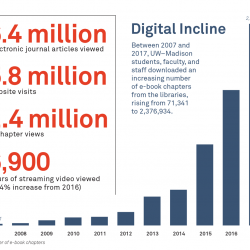

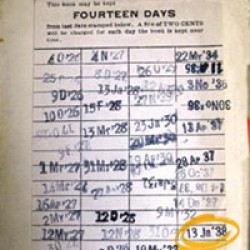
Comments
Dorothea Salo June 2, 2012
Regarding footnote 3: The SLIS Library’s full name is the School of Library and Information Studies Laboratory Library. One of its primary missions, because of the school it’s embedded in, is to be the lab where future librarians and other information professionals learn their trade.
A good many SLIS graduates go on to work in public libraries, where Dewey classification still reigns (though bookstores’ BISAC is making inroads in some smaller public libraries). The SLIS Library is the only place on campus SLIS students can get accustomed to Dewey. Those who will work in academic libraries need only go downstairs a few floors to College Library to see Library of Congress Classification in action.
Hope this helps explain the oddity!
Dorothea Salo
Faculty Associate, SLIS
Felix Chu June 13, 2012
As a practicing librarian, a good chunk as a cataloger, I find this fascinating. I came as an undergraduate in 1967 when Steenbock was new and Helen C. White did not exist. I remember learning my way around the card catalog, particularly at having to deal with Cutter Expansive Classification in the basement and accession numbers on the top stack. At that time, stacks were still closed to freshmen and sophomores. So transcribing information from cards to forms to be handed in for retrieving books was the only link I had to work with. Accurate information on catalog cards matter a great deal.
Felix Chu
Western Illinois University
Peter Staats June 15, 2012
The article notes that the space freed up by the card catalog is greedily pursued by various potential users. Imagine how much space will be freed up in the not-so-distant future when all new books are published only digitally and the existing books are gradually digitized to become bits in the cloud, not volumes on the shelf. Perhaps this is inconceivable to bibliophiles, but then few could imagine the demise of the card catalog when this project was started. As with the card catalog, they will surely keep a few volumes on the shelf to remind future residents of the library building what used to be there.
Emma McElfresh June 19, 2012
Hey there!
I make jewelry from catalog cards, if any are still left floating around – especially any from the 020 section (about libraries and library science) I’d be VERY interested in obtaining them. Please email me if that’s possible! emma@sovereignseadesigns.com
carrie jaszewski June 21, 2012
I bought 2 stand alone card catalogs from SWAP a few weeks ago, and I can testify to their weight of 350 lbs as I had to move them into my basement. They are now retro-fitted to hold CDs and DVDs with style. They still contain their UW inventory IDs, as well as the labels on each door. As my husband and I are both alumni, they will be treasured pieces of now beautiful and functional furniture to enjoy and remind us of our college days, although I’m sure neither of us ever used one while in school! Thanks for sending them to SWAP to be repurposed and enjoyed for years!
Lette B September 16, 2012
Fascinating! I worked in a high school library at a time we were converting the system over and I appreciate all the work that goes into such a project.
Lynn January 25, 2013
The article was wonderful. Thank you for these tactile memories. The photograph was great as well. I wonder if UWM would give any thought to publishing these photographs, along with others in your archive as gift cards that can be purchased ?
I’d love them !
Jasiliu A Kadiri August 16, 2013
A good paper on conversion from traditional librarianship of card catalogs to modern practice. it is a must read for students of librarianship. Kindly send a pdf copy to my mail, I wish to circulate amongst academic colleagues and students.
-Jasiliu A.Kadiri
Marcelo September 25, 2013
Would you still have some cards left? I’m a librarian in Brooklyn and looking for used library catalog cards for a project. I’m happy to pay for the mailing too. Let me know. Thanks!